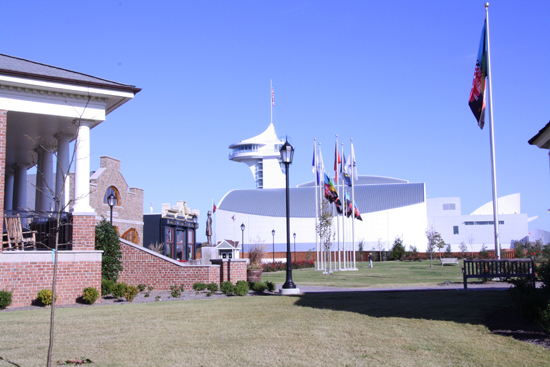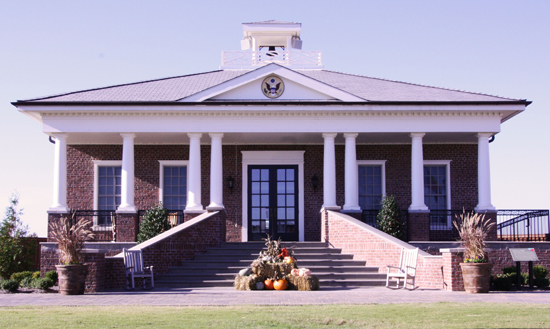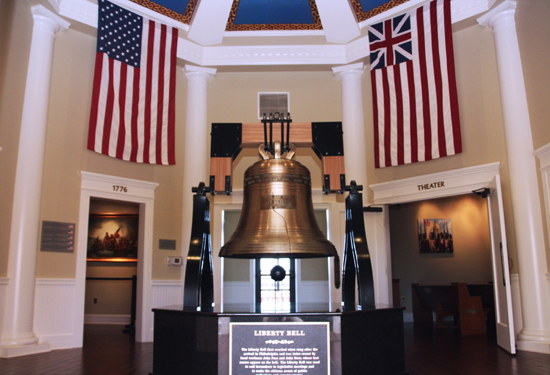Architectural Columns: Classic to Current
![]() Continuing Education
Continuing Education
Use the following learning objectives to focus your study while reading this month’s Continuing Education article.
Learning Objectives - After reading this article, you will be able to:
- Explore the wide range of architectural columns available today, still based on the five classical orders but now including new materials, dimensions and design possibilities.
- Discuss the structure, components and functions of architectural columns.
- Compare the features of both traditional and modern materials used in architectural columns.
- Explain key concepts for specifying architectural columns including code requirements, assessment of structural needs, various configurations possible, and options for custom design.
A millennia-long history in temples, palaces, monuments and capitals from empires to county seats has given the column a special significance beyond most ordinary building components. Even a drawing of a column can suggest “architecture,” as in the logo for the American Institute of Architects. But for an architectural element some would say was perfected in the fifth century BCE, the column has proven to be surprisingly adaptable to the designs and demands of every century since. Today’s column can be manufactured to the most exacting classical dimensions or to an original new design combining components in a way never done before.
This course provides a thorough introduction to the possibilities of today’s architectural column, from the simplest low-cost “off the shelf” columns to new capabilities for customizing, whether the objective is to adapt, replicate or innovate. Important considerations for selecting and specifying columns are considered, including materials, manufacturing, installation, assessing structural needs and meeting code requirements.
Columns are extremely versatile, as examples in the course will show. They are useful and attractive indoors as structural or non-structural room dividers and accents, and provide privacy and style outdoors in porches, loggias, terraces and entertainment areas. Examples old and new express both the enduring legacy and the new capabilities of the architectural column.
Column Structure
The basic function of the column is to bear and distribute weight through compression, but many columns today are purely decorative, and some of the most famous columns in the world from Trajan’s in Rome to Nelson’s in Trafalgar Square are free-standing structures in their own right.

Image courtesy Crown Columns
The column has been used in public monuments and grand residences for hundreds of years, as exemplified in these columns constructed of Western Red Cedar.
As you would expect over thousands of years of use, study and refinement, every smallest subcomponent of the column has its name and variation, from the abacus to the cincture (see Figure below). These variations are the key to recognizing the classical order of the column, discussed below, but they are also what makes the design of contemporary columns so customizable, as the size, number and style of many of these components can be “mixed and matched” in almost limitless ways.
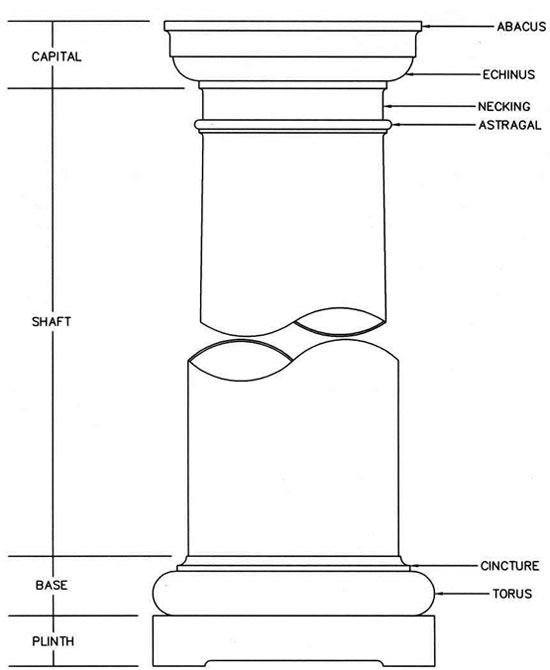
Image courtesy Crown Columns
Major components of the column are shown here, but there are countless other elements and variations.
From top to bottom, the basic major components of columns past and present are:
The capital: the topmost section of the column. The many different profiles of a column’s capital, ranging from very simple to highly ornate, are key identifiers of its order. Depending on the style, the capital may have several “layers” of molding, including the flat abacus slab, the convex disc echinus, and a small convex molding, closest to the shaft, called the astragal, in modern columns usually referred to as the “bead.” A wide range of capitals is available in modern columns, either as part of standard styles, or separately as decorative capitals or custom designs. A standard cast column capital can be “cut at the bead” and replaced with a decorative capital.
The shaft: the vertical element of the column, most often cylindrical but sometimes square or octagonal. Shafts can be smooth or shaped with the vertical hollow grooves called “flutes.” The number and profile of flutes for each classical architectural order is carefully defined, but can be customized in modern columns. Square shafts are available with recessed panels in various sizes, shapes and panel molding. In many ancient columns, the shaft was composed of separate drums, fitted together with engineering skill that would be difficult to achieve today, and relatively resilient to seismic forces. Modern shafts are most often hollow, and can enclose structural supports, or equipment such as wiring and drainage spouts.
Square shafts—either tapered or untapered—are available now in many styles, particularly more contemporary ones. Round barrel cast columns without tapering are also often used for contemporary settings. But the majority of columns manufactured today are circular, with the subtle outward-inward curve known as entasis, often in the same dimensions described by Renaissance architects based on their measurements of ancient Greek and Roman buildings.

Image courtesy Crown Columns
The plain non-tapered 8 inch by 6 foot shafts with chamfered base and decorative capital used outdoors on this porch are inspired by architecture of the Arts and Crafts period in America
The base: In some of the oldest columns, including Egyptian and early Doric in Greece, the columns have no separate base but are placed directly on the floor or pavement. But most columns have a rectangular or square base molding, the lowest part of which is the plinth. The base molding can be quite varied, including for example the semi-circular torus and the ring called the cincture which can also sometimes be found at the top of the column. These are also elements that may be customized, or used with different styles of capital, in coordinated sets or new combinations.
Pilaster: Although not strictly speaking a part of the column, pilasters are ornamental elements that give the appearance of flattened columns and often appear directly behind columns, or sometimes on the sides of a doorway or window. Like columns, pilasters can be plain or fluted, and in the style of the classical orders.
Enduring Order
The definitive statement of how these components look and function, organized into five classic architectural orders, is in a book written by Giacomo Barozzi de Vignola and published in 1562. Vignola presented detailed examples and measurements of ancient buildings to illustrate the precise profiles, details and dimensions of the orders he characterized as Doric, Ionic, Corinthian, Tuscan and Composite.
The first three had already been used masterfully in ancient Greece. The Romans adopted them, and also developed the last two, according to basic principles already recognized by Vitruvius in the first century CE. Vignola and other seminal Renaissance architects such as Andrea Palladio and Vincenzo Scamozzi documented existing buildings and ruins, some just being discovered in their time, and categorized the proportions and characteristics of each order. Vignola’s system for constructing columns in five classical orders has crossed centuries and oceans (see Image below). His principles are reflected in America’s iconic columned buildings, from the US Capitol to the plantation houses of the Old South, with many a bank and courthouse in between, and remain the basis for classically inspired columns today.
The orders are characterized by their elements, the details of their ornamentation, and perhaps most of all by their proportions. For example, the classic dimensions of column height vary by order and are calculated as a ratio between the diameter of the shaft’s base and the height of the column, a Tuscan column being seven diameters high, a Doric column eight, an Ionic column nine, and the Corinthian and Composite columns slenderer still at ten diameters high.
These classic proportions remain a reliable guide even to practical matters like choosing the size of a column for a particular space. For example, a Corinthian column should appear slender with an ornate capital. In an opening space of 9 feet or 108 inches overall, divide by 10 to determine an “ideal” diameter for the Corinthian order. In that example (108 divided by 10 equals 10.8), a column with 10-12 inch diameter would be appropriate. For a simpler form, such as Tuscan, you would divide the total space by 7, for a more massive, plainer look.
The exact dimensions varied even in ancient buildings, and are definitely negotiable in modern designs. The Vitruvian days of selecting orders according to the deity that needed to be pleased are also over (for the most part). But the orders and their distinctive characteristics are still the foundation for understanding columns, a rich resource for carefully designed historic reproductions and the inspiration for new recombinations and designs.
Today, manufacturers often use classical names for their products, some in a way consistent with Vignola’s definitions and other Renaissance models such as the famous Scamozzi capital. The closer the columns are to the classic principles, the more pleasing and durable the end result is likely to be.
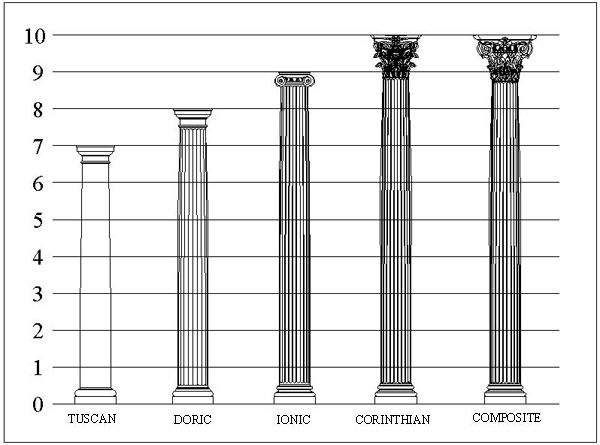
Image courtesy Crown Columns
Vignola’s 16th-century classification of Five Orders of Architecture remains a reliable guide to column profiles, projections and proportions.
Doric. Considered the oldest, the Doric order is often characterized by smooth, round capitals, but they are fluted in many of the most famous examples, like the Parthenon.
Ionic. The Greek Ionic column is distinguished by a slender shaft with 24 flutes, a large base (the tallest base of the three classic Greek orders) with two convex moldings, and a capital usually with two opposing scrolls, also called volutes. Scamozzi developed a four-sided Ionic capital with diagonal volutes, often used with other orders and still the inspiration for many modern column capitals.
Corinthian. Named for the fabled columns and colonnades of ancient Corinth, the columns in this order are the slenderest and most ornate of the classic orders. A slender fluted column is topped by a capital traditionally decorated with two rows of acanthus leaves and four scrolls. Columns in this style can be found inside and outside many buildings on Capitol Hill in Washington, including the U.S. Capitol, the Supreme Court Building, the Library of Congress and Senate and Congress office buildings.
Tuscan. Compared to other orders, the simple, stout Tuscan has the most solid appearance. Prominently featured in Palladio’s Quattro Libri di Architettura, published in 1570, the Tuscan order is the Romans’ simplified adaptation of the old Doric order. Tuscan columns have plain design and generally the simplest of capitals and bases.
Composite: The Composite order typically combines the scrolls of the Ionic with the leaves of the Corinthian. In the Renaissance systems it began to be ranked as a separate order but had been considered as a late Roman variation of the Corinthian.
Other “orders” have been devised more recently. For example, in 1792 Benjamin Latrobe, the second Architect of the Capitol, gave a distinctly American character to Corinthian columns for the Capitol by replacing the acanthus leaves with half-husked corn and flowering tobacco. He wrote Thomas Jefferson that these “corn-cob capitals” had earned him “more applause from members of Congress than all the works of magnitude or difficulty that surround them.”
Comparing Materials
Most early columns were made of stone or marble (except for the very earliest, thought to have been upside down tree trunks), and those remained the materials of choice for hundreds of years. But in the 19th century Greek Revival in this country, when columns became almost a required element not just in religious and public buildings but in homes grand and humble, many of those columns were built of wood. Sometimes the wood was painted or stuccoed to look like marble, but in many cases the wood was used proudly, as a statement about the dignity of ordinary houses in a democracy. Columns weren’t just for palaces and didn’t need to be marble.
Marble, stone and wood are still used in the construction of modern columns, but the majority of today’s columns are composed of new materials, lighter in weight, easier to maintain, and more cost effective. But the traditional beauty and historical accuracy of wood continues to have a timeless appeal.
Stock capitals and bases are generally composed of spun cast polyurethane or engineered resins, but marble bases are also available, and decorative capitals from composite molds of marble and polyester resin in a wide range of styles inspired by or even duplicating classical examples can be combined with wood or fiberglass columns.
Each column material has its own advantages.
Wood
Wood is still a highly desirable alternative, with a character, tradition and authenticity difficult to equal in some applications. Although the number of manufacturers with expertise in crafting wood columns has steadily decreased, it is still possible to find the combination of handcrafting skill and advanced milling capabilities necessary to execute new original designs in wood, or to reproduce historic designs accurately. Wood is also used for architectural column designs inspired by certain periods, such as Arts and Crafts or Shaker style, particularly for interiors, where the warm, aesthetic appeal of natural materials is especially desirable, although the styles can be achieved in other materials.
Quality wood columns are produced from finger-jointed board with stave construction for added strength and stability.
A wide range of different woods can be used, each with distinctly different qualities. Western Red Cedar and clear all-heart redwood are often used for exterior applications, and pine and poplar are cost-effective choices for interiors.
Wooden column shafts are typically treated with a preservative such as asphaltum. Other options available include cutting at the bead for the use of special capitals, cutting to different overall lengths, altering flute length, and splitting to various column configurations. Since most wood columns are created to custom specification, they are typically cut at the manufacturer and splined and tabbed for reassembly on site.
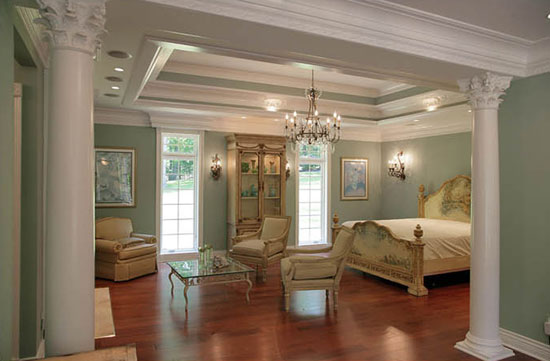
Image courtesy Crown Columns
10 inch x 10 foot plain round interior paint grade lumber columns with decorative capital and custom base and plinth.
Fiberglass
For the majority of columns in buildings today, specially formulated fiberglass polymers are the most practical and flexible options. Cast fiberglass columns are composed of varying amounts of polymers reinforced with fine fibers of glass (FRP or Fiber Reinforced Polymers). Durability in a column is proportional to the amount of fiberglass used. Some manufacturers, for example, use as much as 40 percent fiberglass for enhanced durability. Cultured marble contains less than 4 percent fiberglass.
Fiberglass is highly durable because it is non-porous and essentially impervious to most environmental threats such as moisture, humidity, temperature extremes and insects. Since fiberglass resists stain and decay, it requires little maintenance. Fiberglass is light in weight, so it is relatively inexpensive to transport and to install, and won’t shatter if dropped.
Fiberglass is also highly adaptable. Just as new contemporary designs can be executed in wood, it is also possible for some manufacturers to reproduce historic designs in fiberglass with computer-aided precision, even matching existing columns made of wood.
Cast fiberglass columns can be manufactured in either round or square columns, and generally range from 6-inch through 20-inch diameter and up to 20 feet in height, with a load-bearing capacity of 8,000-30,000 pounds. They are primed and painted with oil-based or latex coatings after installation.
Fiberglass columns should exceed requirements for flame spread and smoke density (SDA) and have an NFPA Class A rating for flame spread and smoke development.
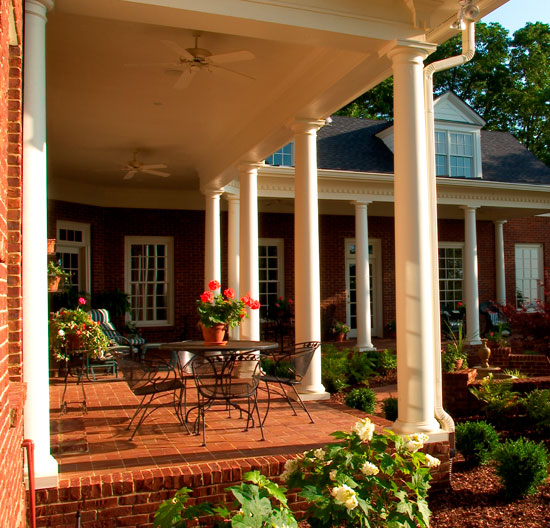
Image courtesy Crown Columns
8 inch x 10 foot plain round tapered fiberglass columns.
Resin Infusion Composite
This material is a composite of E-Glass (an extremely strong fiber) and general-purpose polyester resins. Resin infusion material is specifically engineered for load bearing applications. It has a high modulus of elasticity, a low coefficient of thermal expansion, and can be used to construct columns without seams or joints. Resin infusion columns are particularly appropriate for large exterior columns, with diameters ranging from 14-36 inches. They are light enough so that cranes are not needed for installation, yet with a high content of fiberglass for durability.
The polyester resin portion of the composite structure of this material is sensitive to UV exposure, so extended exposure can cause color shift or yellowing and gloss changes. But this has no effect on the mechanical properties of the column, and can easily be overcome with application of the correct gel coat or paint, which imparts excellent weathering properties.
Filament Wound Composite
The glass filament-winding process allows for a high concentration of fiberglass and a lower concentration of fillers, providing exceptional durability and strength. Filament-wound material is also appropriate for large exterior columns, and does not require cranes for installation.
Pultruded Squares
Columns manufactured using this process are always square in shape. Coated fibers are pulled through a die where, under pressure and heat, the resins are cured. The resulting material has a low rate of expansion and contraction, giving it excellent structural strength and rigidity. It is also highly resistant to chemicals, moisture, scratches, corrosion and fading, making it useful for columns in demanding climates or applications. In fact, they are so strong that they cannot be split.
Cellular PVC (polyvinyl chloride)
Cellular PVC columns are not load bearing, but in other respects this solid, extruded material has the working characteristics of wood. It weighs about the same as softwood and has a high tensile strength of 2,000 to 5,000 psi. It resists deflection in high heat, but becomes brittle below 40 degrees F. Cellular PVC columns require pre-drilling before cold weather installation, especially near edges. Historic accuracy in specialized styles such as Arts and Crafts can be achieved with cellular PVC using precision milling on CNC routers.
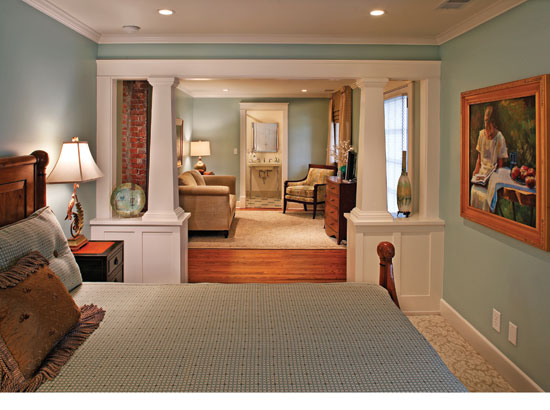
Image courtesy Crown Columns
For the interior of a house in Arts and Crafts style, plain tapered cellular PVC columns with decorative capital and base.
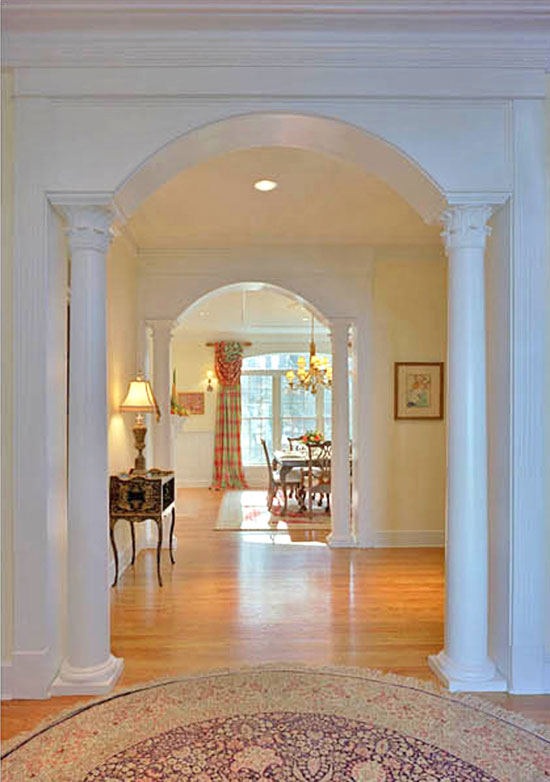
Image courtesy Crown Columns
A plain round lumber column features a decorative capital and base, each with a different style, from composite molds of marble and resin.
Codes and Columns
Column products must comply with the relevant state, county or city building codes, primarily in two important areas: load bearing requirements and surface burning characteristics.
Most U.S. cities, counties and states choose the International Codes developed by the International Code Council (ICC). Some jurisdictions may have specific additional requirements, notably seismic codes in areas with high earthquake risk, and more rigorous recent “uplift” requirements in coastal areas such as High Velocity Hurricane Zone provisions in Florida’s Miami-Dade and Broward Counties.
Load Bearing
Load bearing capacity is related to a column’s dimensions and the material it is made from. Both fiberglass and wood columns come in a wide range of dimensions and lengths. Manufacturers typically provide dimension and length information in tables like the one reproduced here for filament-wound columns. Load bearing capacity – together with other performance characteristics – should be compared for various column types before making a final selection. Shown here is a chart showing a rough general comparison of three materials.
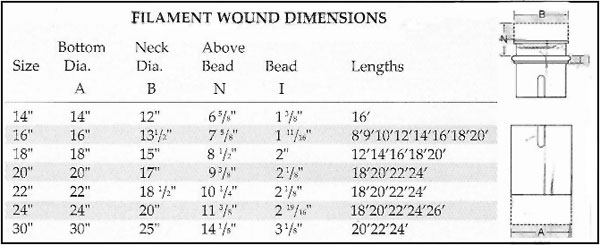
Image courtesy Crown Columns
Filament-wound columns
Material |
Size |
Bearing Capacity |
|---|---|---|
| Filament Wound Fiberglass | 14” | 20,020 |
| Wood | 14” | 10,000 |
| Spun Cast Fiberglass | 8” | 10,500 |
|
Chart courtesy Crown Columns Example of load bearing capacity of materials in different sizes | ||
Surface Burning Characteristics
Code compliance requires that column material meet the test requirements of ASTM E 84 (Standard Test Method for Surface Burning Characteristics of Building Materials). Columns must achieve:
• Flame Spread Index of less than 25;
and
• Smoke Developed Index of less than 450, which meets a Class A Interior Finish Rating.
ICC Evaluation Service (ICC-ES)
ICC-ES Evaluation Reports are a convenient source for specifiers seeking information on the code compliance of a specific column product. ICC-ES is a non-profit, public-benefit corporation that does technical evaluations of building products, components, methods, and materials. The organization develops new evaluation reports and maintains a database of “Legacy Reports” from the four evaluation services that joined to form the ICC-ES in 2003. All evaluations and reports review data supplied by manufacturers for product code compliance. They are available without charge on the web www.icc-es.org
Here is a sample Legacy Report for columns.
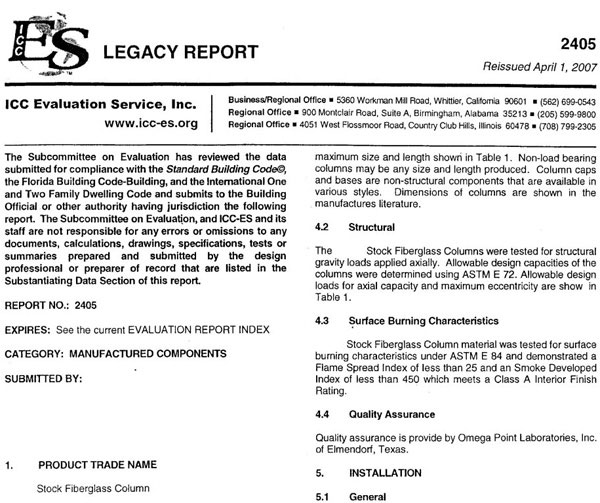
Specifying Columns
As discussed in this course, column possibilities are extensive, whether choosing “off the shelf” columns, combining components for a custom design, or creating an original design. In addition to historic replications, other custom possibilities include pilasters, octagonal columns, columns to surround structural supports, or columns created to original designs.
The Column Options Checklist here (could be in text, or composed as a graphic) summarizes some of the options and considerations. In addition, there are a few basic concepts which are basic parts of using and specifying columns. The column manufacturer should have complete resources and data for making these choices and supporting the entire specification and installation process.
Splitting: Columns can be split to fit different interior and exterior applications, or to surround structural supports. The parts are then splined or tabbed for accurate reassembly. Manufacturers supply tables that specify the size of round or square columns required to wrap a supporting member. Split columns are no longer load bearing. (an image here of the various plans would be great!)
Splitting affects the interior dimensions, so tables are supplied to indicate the exact measurements for specific products.
Cutting “at the bead”: A wide range of separate, decorative capitals are available for wood or fiberglass columns, and as we’ve seen it is also possible to design new capitals. To attach these capitals to the column, the column must be “cut at the bead”, cut flush at the convex molding also called the astragal.
A certain amount of “cut at bead loss” must thus be calculated. Since this causes a varying amount of loss to the height of the column, the manufacturer supplies tables with the estimated “cut at bead loss,” to make sure that the column with the new capital fits the space precisely. Cutting for wood columns is typically done at the manufacturer, but cutting for fiberglass columns can generally be done either at the manufacturer or in the field.
Assembly Options: Some column styles will be available in a choice of assembly options, including flat stock delivery in individual boxes for wrap-around construction and quick installation; columns delivered fully assembled; or “L-wrap,” two L-shaped halves ready to wrap around an existing structural post.
Column Installation and Specification
Column manufacturers provide detailed instructions for the care, handling and installation of their products, along with guide specifications as discussed above. Correct installation is critical to the correct functioning and long-term durability of the column, but column installation is a relatively simple process, and similar for both wood and fiberglass columns.
Here is a sample guide specification for filament wound columns.
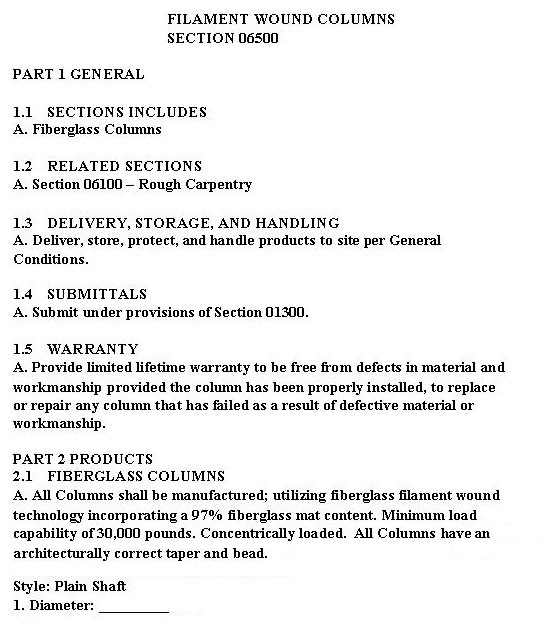
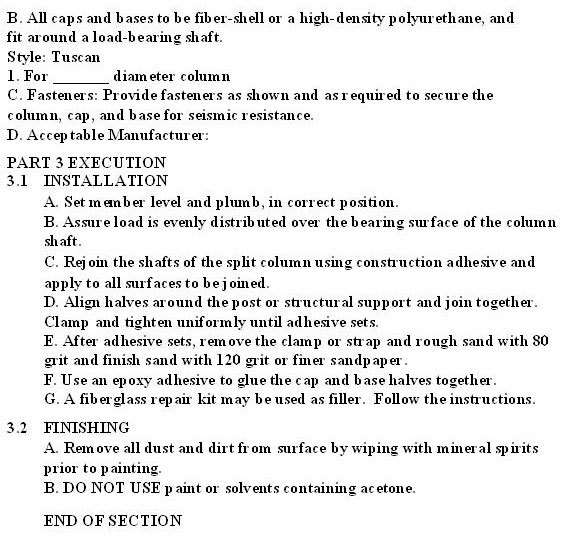
The Order of Today
Technically, there is little to prevent architects today from devising their own new architectural orders. Computer aided milling can execute almost any original design. But there is also no necessity, since the components of existing orders can be replicated, adapted, mixed and matched. These old or new styles can be manufactured in traditional materials like wood or in advanced new composites of fiberglass, resins and polymers. It is still possible to find columns being manufactured to classic standards, sometimes with hand craftsmanship, but also with a wide range of new possibilities and combinations.
Today the column still lends a quality of story, grace and gravitas.
Resources
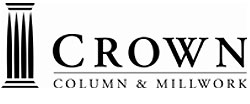 |
Crown Column & Millwork manufactures architectural columns, various styles of fiberglass round and square columns, softwood and hardwood columns, mantle columns, decorative capitals, vinyl and wood porch posts, and composite and vinyl rail systems. |


